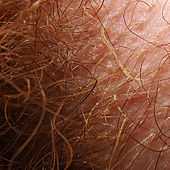Trichomycosis axillaris
| Trichomycosis axillaris | |
|---|---|
| Classification and external resources | |
 An armpit with variably encrusted hairs | |
| ICD-10 | A48.8, L08.8 (ILDS L08.88) |
| ICD-9 | 039.0 |
| DiseasesDB | 32451 |
| eMedicine | derm/601 |
Trichomycosis axillaris is a superficial bacterial colonization of the hair shafts in sweat gland–bearing areas, such as the armpits and the pubic area. It is a trivial disease of worldwide occurrence that is believed to be caused by the genus Corynebacteria (mostly Corynebacterium tenuis).[1]
Presentation
It is characterised by yellow, orange, black or red granular nodules, coatings, concretions that stick to the hair shaft. Usually the condition is symptomless and all that is noticed are sweaty, smelly armpits. Hair shafts may also swell appearing more noticeable after bathing. It results from corynebacterial overgrowth on hair shafts in moist regions of the body and predominantly affects axillary hair (under arms), and to a lesser extent, pubic hair (trichomycosis pubis). It is caused by several species of the gram-positive diphtheroid Corynebacterium, not by a fungus as the name may imply.
Treatment
The fastest method of treatment is to shave the affected hair. Daily cleansing with soap and water and application of benzoyl peroxide (wash or gel formulations) cures the infection. Regular use of antiperspirants aids in prevention by reducing axillary hyperhidrosis (i.e. it staying moist). Topical antibiotic preparations such as erythromycin or clindamycin is occasionally required to eliminate the infection. "Drying" powders may assist treatment.
Prevention
Measures of prevention is trichomycosis limit exposure of children with stray cats, as well as regular inspection of their pets for infection. In animals, fungal infection manifests itself in the form of patches of alopecia on the face, ears, at least - on the feet. In the event of a pet fungus wool should immediately contact the veterinary clinic. The vet will tell you about the necessary methods of disinfection of houses and prescribe the necessary treatment for animals.[2]
See also
References
- O'Dell ML (1998). "Skin and wound infections: an overview". Am Fam Physician 57 (10): 2424–32. PMID 9614412. Full text
- http://www.emedicine.com/derm/topic601.htm
- http://dermnetnz.org/bacterial/trichomycosis-axillaris.html
External links
References
- ↑ Rapini, Ronald P.; Bolognia, Jean L.; Jorizzo, Joseph L. (2007). Dermatology: 2-Volume Set. St. Louis: Mosby. p. 1089. ISBN 1-4160-2999-0.
- ↑ http://medusanews.com/diseases-and-conditions/dermatology/trichomycosis.html